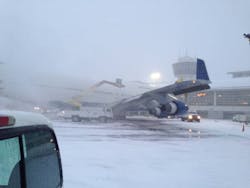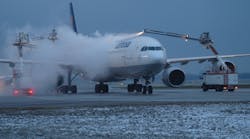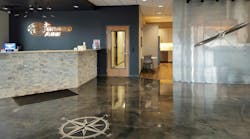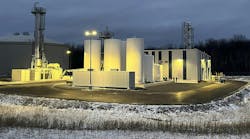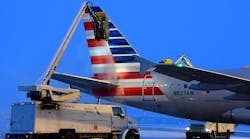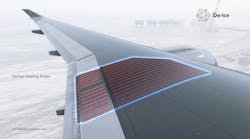Prior to 1992, the length of time that aircraft deicing fluids (ADF) provided protection was overestimated by most commercial airlines. This was realized after the crash of U.S. Air Flight 405 at LaGuardia Airport, in which a long queue caused ice to re-accumulate on the plane's wings and airframe after ADF had been applied.
Bryan Wagoner, the Environmental Programs Administrator at Detroit Metropolitan Airport (DTW), says this incident spurred a nationwide focus on deicing practices.
"The FAA mandated that every plane must be absolutely free of snow at the end of the runway prior to take-off," he explains. This resulted in a significant increase in the quantity of ADF used nationwide.
Midwestern winters, however, can be unpredictable. Months can go by with little to no precipitation, and then a snowstorm worthy of national news can hit with a fury.
Wagoner says that after the amount of aircraft deicing increased, the amount of runoff containing spent ADF did too. DTW, like many airports at the time, didn't have an adequate disposal method in place.
"Everyone was learning on the fly," he adds, noting that the overflow would go into ponds or nearby creeks and rivers when it couldn't be handled by the treatment plant. "It was bad news all around,” he exclaims.
Wagoner says that it was a perfect environmental storm. At the same time deicing runoff was increasing, flight traffic at many airports was as well. Airplanes would be deiced at the gate then by the time they got to runway, accumulating more snow or ice on the way; they would have to come back for Round 2.
Since the airlines were responsible for the deicing process and the airport was responsible for the runoff management, the two had to come together to design and build remote deicing pads.
The airlines were reluctant at first to accept the concept, but Wagoner says once they realized it was a good operational procedure, they supported dramatic expenditures. DTW now boasts four deicing pads, ensuring the safety of the planes, and also a high concentration of runoff.
DRAMATIC DEICING
The airport's deicing recycling program took full speed at this point, in the early 2000s. EQ Resource Recovery Inc., a local recycling vendor, has partnered with DTW, in a relationship that's proven to be a win/win.
During the winter of 2004-2005, it's estimated that DTW’s recycling program collected 888,000 gallons of pure deicing fluid, which otherwise would have had to be treated at the undersized sanitary treatment facility used by DTW. While it saved the airport substantial amounts of money, it also placed DTW as the largest ADF recycler in the world.
"From 2000 to 2010, we were just spraying and recycling," says Wagoner. "The airport was getting paid for the value of the reclaimed deicing fluid, and EQ was paying for the collection, transportation and processing. The benefit was huge."
Every year the airport would receive a check for an amount up to $90,000, but the dollars being saved in treatment costs went into the millions.
EQ was "tickled pink" he says because they were receiving high concentrated runoff, and recycling it to sell for product manufacturing.
In those days, he explains, an aircraft was sprayed with a 50/50 blend of aircraft deicing fluid mixed with water. The blend had enough deicing fluid to protect a plane in the worst-case of cold temperatures, typically to minus 10 to 15 degrees Fahrenheit. When it was sprayed at 50 percent, it could be picked up by EQ at 45 percent, he adds. EQ’s break-even point was 8 to 10 percent, so this was a decade of unique proportions.
CHANGE IS GOOD
DTW continues to use the state-of-the-art deicing pads to collect the runoff, but Delta Air Lines has taken the process a different direction in the last couple years. When the cost of deicing fluid began to soar in the late 2000s, the airline, which accounts for 80 percent of the air traffic at DTW, began to realize that it wasn’t necessary to spray ADF at 50 percent, when milder weather didn’t require it.
"It sounds easy," says Wagoner, but "once you start adjusting blends, different trucks and tanks, keeping accurate track when the weather changes quickly is difficult."
Prior to the 2011 winter season, Delta spent approximately $1.5 million on a blend-to-temperature system. Wagoner says they have a very robust data collection and monitoring center with real-time analytical capabilities. With 50 trucks in their deicing fleet, the airline blends often in wintry weather, matching the temperature with the blend needed to protect the aircraft.
"It's pretty amazing," Wagoner says, explaining that the system records what went on each plane, and who made the application. Ten to 12 people man the deicing control tower, and are linked to locations worldwide.
According to Robert VonHusen, a Delta supervisor with 17 years of experience in Detroit’s deicing operation; the airline has a team of more than 250 skilled deicers at DTW who work diligently to make sure each plane is deiced safely.
"Implementing this refined blending process in Detroit has required a fundamental shift in the way we approach deicing aircraft,” he says. "To run a safe and reliable operation while also driving down costs and reducing our impact on the environment, we continue to have to be diligent. The team here in Detroit has met the challenge head on and we’ve seen some very positive results."
The carrier says the re-tuned process can save thousands of dollars per aircraft in reduced fluid usage and dramatically reduces runoff onto the airport ramp areas.
The airport also saw an amazing shift with this program.
"All of a sudden they're spraying 10 or 15 percent, instead of 50," Wagoner explains. "It changed the economics of the recycling equation, big time."
The money and environmental savings have been a huge benefit overall. DTW, though, has found itself in a sticky sanitary treatment situation. While a drastic decline in the amount of recycling has occurred, the amount of runoff pumped through the sanitary treatment plant has increased.
While the more concentrated deicing runoff still goes through EQ, the dilute runoff is sent through the treatment plant.
"It's not quite as good a deal as we all thought," says Wagoner. "The whole spectrum of what we pick up is more dilute."
This is fine, if an airport's sanitary system can handle it, Wagoner adds. In 2012, DTW added another facility to pitch in, and allow for redundancy. As a result, the airport has incurred an extra million dollars a year in treatment costs.
While the environmental benefits are not disputed, Wagoner recommends airport executives do some in-depth modeling before making any big changes.
"As best you can, forecast what your future stream is going to look like," he explains. "Make sure you can handle everything properly." While he says he saw this predicament coming, even this long-time industry expert underestimated the full impact on the airport’s sanitary system and associated costs.
Airports in locations with an unpredictable winter season have to be prepared, one way or another. Wagoner says DTW is extremely proud of the deicing recycling program it has used for many years, and has been a big success. He refers to the deicing pads at DTW as similar to watching a ballet. The four trucks, move in and spray, then move back. The plane is then ready for take-off. The deicing process at DTW is an example other airports can learn from.
About the author: Jen Bradley is a freelance writer, based in East Troy, WI, who specializes in writing about aviation issues.
